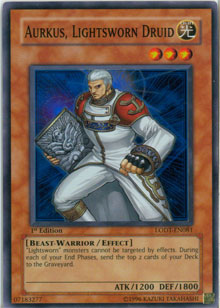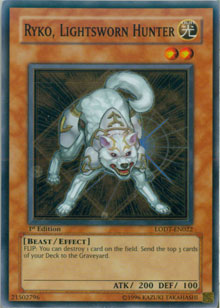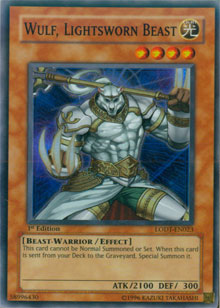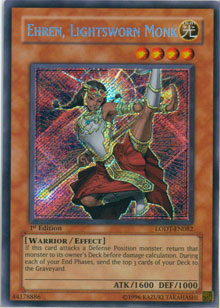"Just be glad he can’t turn into a bear."
Sure, Light of Destruction already had great Lightsworn cards, but why stop there?
We Yu-Gi-Oh! TCG players are the lucky recipients of three all-new World Debut Lightsworn cards that certainly have a justifiable place in a Lightsworn deck. You already have a good idea of what the others can do, thanks to their own fan base and my fellow Metagame.com writers, but the newest additions remained a surprise until the Light of Destruction Sneak Preview weekend.This week, we examine the mechanics of the new Lightsworn TCG exclusives.

Lightsworn of D.
"Lightsworn" monsters cannot be targeted by effects. During each of your End Phases, send the top 2 cards of your Deck to the Graveyard.
Kaiba’s Lord of D. prevents all Dragon-type monsters from being selected as the target of a monster, spell, or trap card effect. In the old days, non-targeting effects from cards like Raigeki and Dark Hole were more likely to smite your mighty Dragon, so his effect was a bit mismatched. As time progressed, more targeting effects rose to prominence and the Forbidden list eliminated a few of the nastier non-targeting spell and trap cards.
Aurkus, Lightsworn Druid’s effect doesn’t actually negate anything, and this will confuse inexperienced players just as much as it did with Lord of D.. Aurkus’s effect prevents either player from declaring a face-up "Lightsworn" monster as a target when he or she activates an effect. It even goes a step further than Lord of D., preventing Lightsworn monsters in the graveyard and removed-from-play pile from being targeted. You can still activate effects that target other monster cards or face-down Lightsworn monsters, but the remaining Lightsworn monsters on the field will be off limits.
If a card asks you to select a monster when you activate it, it is easy to recognize that these cards target and thus won’t do any good against Lightsworn monsters while Aurkus is on the field. Equip cards can’t select a Lightsworn monster, Brain Control is out of luck, and Ring of Destruction has to find someone else to blow up. Monsters like Snipe Hunter, Dark Armed Dragon, and Caius the Shadow Monarch find the Lightsworn monsters off limits and have to direct their attention elsewhere.

Example: Limited Selections
Player B can activate Shield Crush and select Player A’s face-down Ryko, Lightsworn Hunter, but she cannot select Aurkus, Lightsworn Druid. Brain Control cannot be activated, because Player A doesn’t have a monster that Player B could select as its target.
Aurkus’s effect can sometimes prevent cards from activating because they would be required to select a Lightsworn monster as their target, and Aurkus won’t allow it. Our example showed us what happened to simpler cards like Brain Control, but what about targeting effects that aren’t quite so clear? When your Lightsworn monster attacks while Aurkus is on the field, your opponent would not be able to activate Sakuretsu Armor because Sakuretsu Armor would not be able to select the attacking Lightsworn monster as a target. Sakuretsu Armor, Dimensional Prison, and Trap Hole are in the limited category of effects that target but don’t allow you to decide what card is affected. We don’t have very many effects like these, so it isn’t something you will run into very often, but it’s important to be aware of.
I mentioned earlier that Aurkus, Lightsworn Druid doesn’t negate effects, he just ensures that they aren’t allowed to select Lightsworn monsters as their targets. In order to do this, Aurkus needs to be face up on the field at the time the Lightsworn monster would be targeted. If Aurkus is placed onto the field after the target has already been selected, his effect won’t do anything.

Example: Not So Glorious
When the chain resolves, Aurkus is special summoned in attack position. When Enemy Controller resolves, it shifts Wulf into defense position. Wulf was already selected as the target for Enemy Controller before Aurkus was placed onto the field, and Aurkus has no way to negate Enemy Controller.
This limitation to Aurkus’s effect also means that any card equipped to Lightsworn monsters when Aurkus, Lightsworn Druid is summoned will remain equipped and continue applying its effect. Aurkus’s effect also cannot prevent you from using a Lightsworn monster to pay the cost for an effect. When you tribute or otherwise send a Lightsworn monster to the graveyard to pay a cost, it is not being targeted.

Pigtails and Beatdowns
If this card attacks a Defense Position monster, return that monster to its owner's Deck before damage calculation. During each of your End Phases, send the top 3 cards of your Deck to the Graveyard.
Whenever Ehren, Lightsworn Monk attacks a defense-position monster, her trigger effect activates and starts a chain before damage calculation. When it resolves, the defense-position monster she attacked is placed into its owner’s deck and his or her deck is shuffled. Normally, these effects will destroy the monster and place it into the graveyard or on top of its owner’s deck. Shuffling it away is a new twist. A monster placed on top of the deck or into the graveyard is much easier to access than a monster lost into the randomness of the deck.
Those of us familiar with Drillroid already know how the story goes. The monster returned to the deck is still flipped before it is returned, so if it has an effect that activates when it is flipped face up, it will start a chain after returning to its owner’s deck.
Example:
Ehren, Lightsworn Monk attacks a set Penguin Soldier. After Penguin Soldier is flipped face up, Ehren’s effect activates and returns the Penguin to its owner’s deck. Once it is returned to the deck, its effect starts a chain and it can return Ehren to her owner’s hand.
One final situation you may encounter: Blast Sphere. When Ehren attacks Blast Sphere, these two monsters’ effects form a chain. Given that Ehren is attacking, it’s a safe bet to say that she is controlled by the turn player. As such, her effect is placed on the chain first, followed by Blast Sphere. When the chain resolves, Blast Sphere equips to Ehren and Ehren’s effect disappears.
Until next time, send all comments and questions to Curtis@Metagame.com.